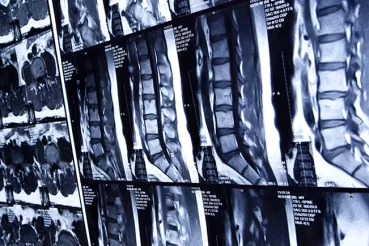Most people experience back pain at some point in their lives — in fact, lower back pain is the second-leading reason Americans miss work. The source of that pain can be anything from a muscle spasm to a herniated disk to osteoarthritis. It could also be a benign or cancerous spine tumor.
While spine tumors are relatively rare (only one person in 100,000 develops a spine tumor each year), if you have one, the impact can be life-altering.
When caught early, however, doctors can often treat spine tumors effectively and improve your quality of life, says John O'Toole, MD, MS, a neurological spine surgeon at RUSH MD Anderson Cancer Center.
Know the signs
When it comes to spine tumors — whether they are cancerous or noncancerous, found on vertebrae or the spinal cord — back pain is the most common red flag. "The tumor causes pain by pressing against the spinal column or destroying the bone, and it differs from some other types of back pain in that it worsens at night or during rest," O'Toole says.
Pain can also radiate to other parts of the body and, with spine tumors, typically gets worse rather than improving with time as one would see with muscle strains or typical degenerative conditions, O'Toole says. Other warning signs include loss of sensation or muscle weakness, difficulty walking and decreased sensitivity to pain, heat and cold.
People who have had cancer (especially cancers originating from the lung, breast, prostate, kidney and thyroid) should be especially vigilant about monitoring symptoms of spine tumors: In approximately 60% to 70% of patients with cancer, the disease spreads — or metastasizes — to the spine.
Other people at risk for spinal cord tumors include those with neurofibromatosis 2, von Hippel-Lindau disease (a rare genetic condition) and compromised immune systems (spinal cord lymphomas affect immune cells called lymphocytes).
Early diagnosis is key
Cancerous and noncancerous spine tumors that push against spinal nerves can be painful, debilitating and even life-threatening. They can lead to loss of movement and sensation below the location of the tumor, and affect bladder and bowel function as well. If undiagnosed and left untreated, nerve damage can be permanent.
"We don't want patients to be in pain any longer than they have to be. That's why early diagnosis is so important," says O'Toole.
If a spine tumor is suspected, doctors will order additional tests to confirm the diagnosis and identify what type of tumor it is (e.g., meningioma, schwannoma, neurofibroma, osteosarcoma, Ewing’s sarcoma, osteoid osteoma, osteoblastoma, hemangioma, chordoma), whether it is benign or malignant, and how aggressively it is growing.
The plan for how best to treat the tumor depends on several factors, including the patient's age, health and type of tumor. The ultimate goals are to remove the tumor, relieve pain and restore the patient's ability to move and get around. But if a tumor is small, slow-growing and not causing problems, doctors may actually recommend not treating it right away.
In some cases, the risks of surgery, radiation or medication actually outweigh the benefits, especially for some older patients, and the team suggests simply monitoring the tumor with periodic CT or MRI scans.
"It's the same sort of watch-and-wait approach that's often used for low-risk, slow-growing prostate cancers.," O'Toole explains. "If tumors become more aggressive down the road or start to cause increased pain and disability, we look at treatment options and determine what is best for the patient."
We have the ability now to deliver higher doses of radiation in more targeted ways, so we can shrink or destroy tumors without harming healthy tissue.
Finding relief through treatment
Of course, sometimes surgery is the best option. O'Toole says removing tumors surgically is now easier on patients thanks to advances that have enabled better visualization and less risk of nerve damage (doctors can test nerves during surgery with electrodes).
If the surgeon can't completely remove the tumor, chemotherapy or radiation therapy may then be added to the treatment regimen.
Radiation therapy is also used for tumors deemed inoperable because of their size or location, and newer types like stereotactic radiosurgery allow radiation oncologists to deliver higher doses with far greater precision.
"Radiation oncologists have the ability now to deliver higher doses of radiation in more targeted ways, so they can shrink or destroy tumors without harming healthy tissue," O'Toole says. "And they can do this with shorter treatment sessions, which patients appreciate because it means they spend less time in the hospital."
Expert advice
The bottom line: The earlier spine tumors are diagnosed, the more treatment options you have. So if you have back pain that won't go away, see your doctor: Don't wait until the pain becomes unbearable.
O'Toole also recommends seeking a second opinion if you feel uncertain about your diagnosis or the treatment options you're given. "You need to feel like you are in the right hands," he says.




